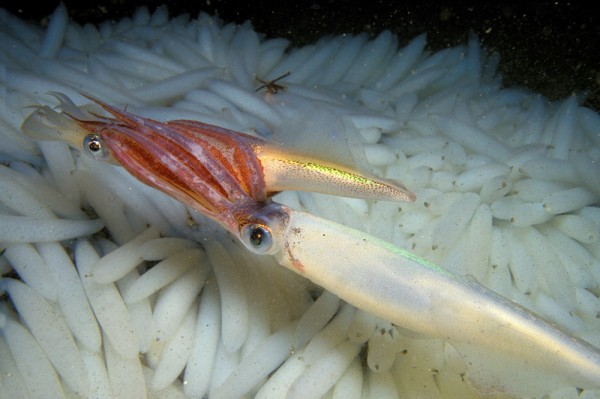Female Squid Flash Fake Testes
Two common market squid mate off the California coast above hundreds of egg masses (white, tube-shaped objects). Photograph by Mark Conlin, Alamy
How’s a female supposed to turn away unwanted male attention? If you’re a market squid (Doryteuthis opalescens), just flash fake testes.
Female market squid can control the appearance of a white stripe down part of their body that mimics the approximate size, color, and position of testes on male squid. Researchers think females flash their false boy parts to escape the aggressive attentions of male squid during mating.
Near the end of their life, hundreds of thousands, if not millions, of market squid gather in huge groups to reproduce. Once the squid mate, the females will lay tubes of eggs on the seafloor and get drawn into the aggregation to mate again.
But this can be a violent process. “The females can be killed by aggressive bouts of mating,” said Daniel Morse, professor of biomolecular science and engineering at the University of California, Santa Barbara.
At the very least, the males end up tearing the skin on the female squid, added Daniel DeMartini, a graduate student at the University of California, Santa Barbara.
“To avoid male aggression, [the females] can turn this stripe on to match a male temporarily while they’re catching their breath in between all this mating and spawning,” he said.
That’s one hypothesis explaining the presence of a set of stripes—two iridescent, rainbow-colored ones surrounding a white stripe—on female market squid that Morse, DeMartini, and colleagues have proposed in a study published this month in the Journal of Experimental Biology.
Adaptive Colors
Cephalopods—sea creatures including squids, cuttlefishes, and octopuses—are known for their quick-change coloration. They are able to manipulate specialized cells scattered throughout their bodies to produce a myriad of colors.
“Adaptive iridescence,” the ability to turn iridescent colors off and on, is not a new skill for this group. But the ability to manipulate a type of cell called a leucophore—which produces the white coloration—is new, said study co-author DeMartini.
Cuttlefishes and octopuses have leucophores that are always “on,” or always white, he said. But this is the first time researchers have seen the ability to blink the cells off and on in any cephalopod.
DeMartini had been working on the ability of squid to turn colors off and on as part of his dissertation for years. He specializes in studying how the animals accomplish this at the cellular and molecular level.
Off and On
DeMartini noticed the white stripe on the females, but he ignored it at first. Then he realized that only the females had them. So he started to look into it.
What he found was that the same group of proteins—called reflectins—that control color changes in cells responsible for iridescence were also responsible for turning on the leucophores responsible for the color white.
But scientists still don’t know how squid turn their colors off. Figuring that out is next on the agenda for DeMartini and Morse.
“In virtually all of biology, the on signals differ from the off signals,” explained Morse. It’s as true for the insulin pathway in people as it is for the color pathway in cephalopods. Turning something off is “not just simply stopping the on switch.”
The neurotransmitter acetylcholine flips the on switch in these squid, he said. “[And] we think there’s a related but different neurotransmitter that can turn off the switch.”
Hunting down the off switch is one of the highest research priorities for Morse and his lab.
And the hunt is far from over, said DeMartini.(Posted by Jane J. Lee in Weird & Wild on September 11, 2013)












